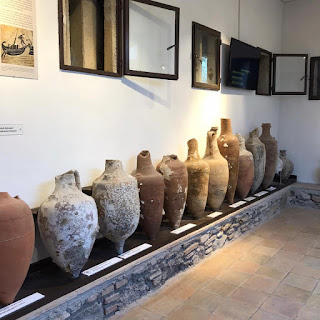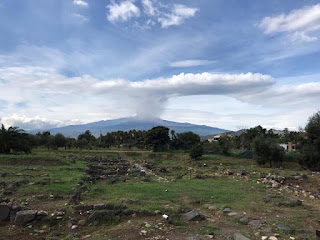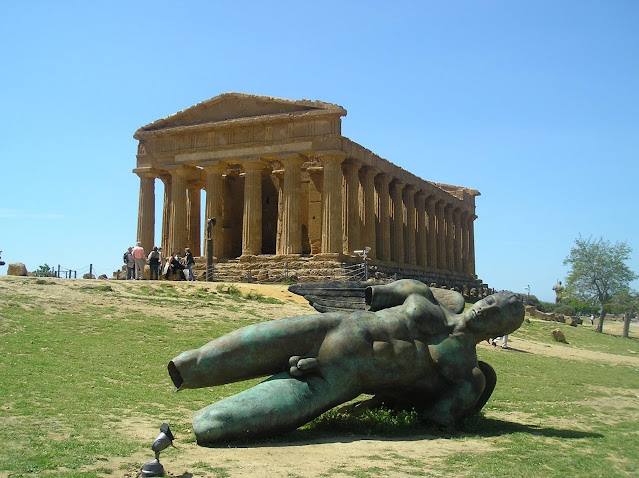Giardini Naxos ... The Archaeological Park & Museum
Naxos or Naxus was an ancient Greek city situated where is now the seaside resort of Giardini Naxos near Taormina. This ancient city occupied a low headland, now called Capo Schisò, which was formed by an ancient lava flow.
Naxos was the first Greek colony in Sicily, founded in 734 BC by settlers from Chalcis in Euboea and later from Naxos in the Cyclades Islands. The city was strategically positioned on the east coast, south of Messina and was a natural landing point for ships sailing west to Sicily from Greece.
In 492-491 BC Naxos was conquered by the tyrant Hippocrates of Gela and then again in 476 BC by the tyrant Hieron who transferred the citizens of Naxos to Leontini (modern day Lentini). Soon afterwards a new city with a grid plan was laid out and in 461 BC the exiles returned after the fall of tyranny in Siracusa.
Naxos as an Ionian city was an ally of Athens in the fifth century BC who along with the colonies of Leontini and Katane (Catania) supported Athens in its campaign against Siracusa during 415-413 BC. For this reason, the city walls and houses of Naxos were reportedly raised to the ground in 403 BC by Dionysius of Siracusa after Athens was defeated in the Peloponnesian War.
Dionysius made himself the new ruler of Naxos after the treachery of the cities general. After this Naxos never again had the rank or role of a city although its harbour remained active throughout antiquity. Urban life shifted to Tauromenium (Taormina) which was founded in 358 BC and Tauromenium received the exiles from Naxos.
The memory of Naxos as the earliest of all Greek colonies was preserved though with the dedication of an altar outside the town to Apollo Archegetes, who was the divine patron under whose authority the first settlers had set sail. It became a custom that all envoys on missions to and returning from Greece should offer a sacrifice at this altar.
The story of Naxos came to an end after just three centuries. This makes it a privileged observation for the study of the oldest urban life of Greek towns in the west. Much of ancient Naxos has never been built on and many parts have been excavated in recent years.
Its remains are open to the public and its museum boasts many finds.
Naxos was one of the few Greek colonies in Sicily that the great Sicilian archaeologist Paolo Orsi did not conduct any excavations. They had "unfortunately been made impossible due to the intensive farming in that area" which he pointed out with regret in his notebooks in 1925. He was in fact very aware of the importance that such excavations would have had for the study of the earliest phases of Greek colonization in Sicily.
The now excavated ruins, defensive walls and part of a temple, are now enclosed within a nicely kept park abundant with citrus trees, olive trees, pine trees and prickly pear cacti whilst Mount Etna keeps a watchful eye in the distance. A museum houses finds from the site and the ancient fort boasts finds recovered from shipwrecks in the Bay of Naxos and Taormina area.
On the first Sunday of every month in Sicily all regional archaeological sites and museums are free to enter so last October on a partly cloudy Sunday with Mount Etna in eruption we decided to take advantage of the free entry and went for a leisurely walk around the park with our dog Daisy. Being a history geek I love walking around archaeological sites which is why Sicily is the perfect place for me.
We had only ever been into the park once since we bought our house in Giardini Naxos and that did not end well as somehow I ended up with spines from a prickly pear cacti stuck in my fingers. It was a very hot and sultry August day, over 90 degrees, which really was not helping with the pain and then we got lost in the park (yes it is that big) and we could not find either exit (there are two). Eventually we found our way out and I ended up having to put my sore and throbbing hand in the "La Sirena" fountain on the Giardini Naxos seafront to cool it down and then have the spines tweezered out by my amused husband once we got home. Note to self on my next visit, stay away from prickly pears.
On our latest visit as we walked into the parks main entrance the first point of interest was the old Bourbon fort. In here we found the maritime items, mostly anchors, millstone grinders and amphorae which were containers used for the transportation and sale of liquids such as oil and wine and also solid produce such as wheat, meat and salted fish. The millstone grinders are thought to be from Roman times. We learned that on board Roman ships 'panis nauticus' were eaten, which are a kind of un-leaven biscuit which kept for a long time. Grains would have been held in the ships hold and were ground with the grinders, then mixed with seawater and made into loaves or biscuits. The millstones were quite often made from volcanic rock. Numerous anchors have been found in the bay of Naxos and Taorminese sea dating back to not just Greek times but also Roman, Byzantine and late Medieval ages. On the walls of the fort there is extensive information displayed on boards with photos, illustrations and stories about the history of the surrounding sea, its shipwrecks and local underwater archaeological finds.
Next we headed for the museum.
The archaeological museum is a two storey building that is well stocked with interesting artifacts which were found at the site and it is a little gem. The museum has fantastic items such as pottery, sculptures, drinking cups, helmets, gorgon heads, Greek and Roman coins plus many more items that make you stop and think about what is in front of you. On the walls boards display a wealth of information and diagrams of the layout of ancient Naxos making it very educative and it can take a while to go around if you read everything. The museum is very interesting and provides a great introduction to the history of Naxos and certainly made me turn on my inner archaeologist mode.
Naxos pottery production made use of clay found in areas very close to the town. Two potter's quarters have been excavated and show evidence of being active in the 5th century BC. Most notable in the museum is the masks of gorgons and Silenus. At Naxos there was a great veneration for Dionysius the Greek god of wine and vines (not to be confused with Dionysius of Siracusa). Silenus was the inseparable companion of Dionysius. Since the end of the 6th century BC the image of Silenus was much used in the decoration of the roofs of temples, private houses and public buildings, in fact over 400 of these masks have so far been discovered at Naxos. The closeness of Mount Etna is thought to have contributed to the popularity of his image. In an ancient Greek play Silenus is the elderly servant of the cyclops and in mythology both Naxos and Katane (Catania) were supposedly situated in the land of the cyclops.
After the museum we were ready to explore the archaeological site.
There is actually not too much to see as in other archaeological sites in Sicily but there is enough to make you use your imagination as you stroll through the park. The ancient Naxos settlement occupied an overall surface area of 40 hectares. The park is made up of several sites, the archaic settlement, the sacred areas, the south eastern shrine, the urban shrine west of the Santa Venera stream, the 5th century BC settlement, the north and west necropolis and the Hellenistic necropolis. The park has been divided into plateaus which are clearly marked with information boards so that you know where you are.
The first area phase of building was the archaic settlement close to the sea, the buildings would have been modest and small. Here there were numerous sacred areas forming a sacred precinct. Some were wiped out by the new urban layout in the 5th century BC, whilst others survived. Starting from the beginning of the 6th century BC decoration would have become more common on the buildings with figures and lotus flowers painted on them and they would have been adorned with the masks of gorgons and Silenus that we saw in the museum.
In about 475 BC a new rigidly geometrical town layout replaced the archaic one. The town space was divided up by three east to west roads, plateau A, B and C which differed in width with the central one (A) being wider than the other two which would have had dwelling blocks. Each block would have comprised of about forty houses.
The north necropolis was only recently found in 1980 and has so far revealed 400 tombs. The west necropolis was more distant from the town and so far only 100 graves have been found. In the south western area there are remains of a sanctuary which is thought to be dedicated to either the goddess Aphrodite or Hera. Also in the park we found two furnaces that were probably used for baking bread.
As we walked around just by looking at the ancient stone foundations we could make out the grids of where the roads would have existed and the scale of the rooms of each house. It was easy to imagine how ancient Naxos would have looked with the hustle and bustle of ancient Greek life under the shadow of a smouldering Mount Etna. The site is very tranquil with only the sound of bird song and the sound of the sea in the background.
Excavations are still ongoing and discoveries are still being found as I write.
The park is open daily from 9am to sundown so why not take a step back in time when in Giardini Naxos and take an interesting walk in the footsteps of the ancient Greeks, the park boasts history, mystery, ruins and intrigue.
Just don't touch the prickly pear cacti but if you do my husband is very good with a pair of tweezers.
For more Information visit
For Underwater Archaeological Diving Courses
contact Alex Lentini at
To find out more about the modern day resort of
Giardini Naxos,
Giardini Naxos,
its myths, legends and what to see and do and eat
visit my previous post;
visit my previous post;
"Giardini Naxos … My Town"
https://whitealmond-privatesicily.blogspot.com/2020/02/giardini-naxos-my-town.html
https://whitealmond-privatesicily.blogspot.com/2020/02/giardini-naxos-my-town.html
Photo Gallery
Thank you for following me at
White Almond Sicily Blogspot
as seen in
The Ultimate Guide to Visiting Sicily
by Essential Italy
and
featured in the novel
"My Lemon Grove Summer"
by Jo Thomas
For NEW Blog updates and all things Sicilian
follow me on Social Media at
Instagram www.instagram.com/whitealmondsicily/
Twitter www.twitter.com/sicilyconcierge/
For Travel Tips, Trip Advice and Recommendations
Email me at WhiteAlmondSicily@Gmail.Com
or fill in my Contact Form
Love Sarah x
🌵🌵🌵


























































